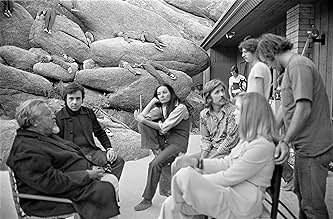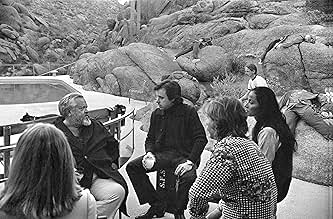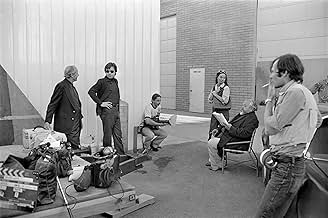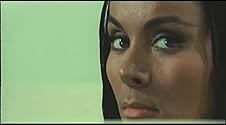CALIFICACIÓN DE IMDb
6.7/10
8.4 k
TU CALIFICACIÓN
Un director de Hollywood regresa tras un tiempo en las sombras para completar su trabajo en una innovadora película.Un director de Hollywood regresa tras un tiempo en las sombras para completar su trabajo en una innovadora película.Un director de Hollywood regresa tras un tiempo en las sombras para completar su trabajo en una innovadora película.
- Dirección
- Guionistas
- Elenco
- Premios
- 9 premios ganados y 8 nominaciones en total
Robert Random
- John Dale
- (as Bob Random)
- Dirección
- Guionistas
- Todo el elenco y el equipo
- Producción, taquilla y más en IMDbPro
Opiniones destacadas
I had the privilege of seeing this at the New York Film Festival. A sense of awe descended upon the audience as soon as the opening credits began. The fact that this film was finally completed and released is a triumph in and of itself.
Orson Welles' final film is chaotic and unwieldy, but also very haunting and melancholy. The soundtrack is amazing. There is frankly a sliver of a plot. An aging director attempts to make a comeback as Hollywood has drifted away from his era as he throws a big birthday party in which journalists, critics, admirers and some industry professionals join to celebrate. It soon becomes apparent that reporters are there to ascertain information about more than his work. His new film that is in the works is shown. We get to see an unfinished film within a film that is titled "The Other Side of the Wind", one that is sexually explicit.
The late John Huston portrays Jake Hannaford, the director whose approach to filmmaking has earned him a great following and his relationships with the actors he works with makes him a lightning rod of controversy. Huston's sepulchral voice and domineering presence make him flawless in the role as Hannaford. Peter Bogdanovich is well utilized as a younger, successful director whom Hannaford has taken under his wing but whom now Hannaford consults on how to better reach audiences of the new era.
This film is not flawless. The experience of seeing this at long last outweighs its drawbacks. There are some parts of this film that drag a bit. But there are also many, many scenes that are just astounding and I'm so happy they were finally brought to the big screen. Although this film is inconsistent in its narrative thrust, it returns very quickly to its busy, slightly manic state. I don't know if Welles deliberately left this unfinished. What I can say is that the editing is superb and provides us with a film that is a lasting testament to Welles and his legacy as a filmmaker. Highly recommended.
Orson Welles' final film is chaotic and unwieldy, but also very haunting and melancholy. The soundtrack is amazing. There is frankly a sliver of a plot. An aging director attempts to make a comeback as Hollywood has drifted away from his era as he throws a big birthday party in which journalists, critics, admirers and some industry professionals join to celebrate. It soon becomes apparent that reporters are there to ascertain information about more than his work. His new film that is in the works is shown. We get to see an unfinished film within a film that is titled "The Other Side of the Wind", one that is sexually explicit.
The late John Huston portrays Jake Hannaford, the director whose approach to filmmaking has earned him a great following and his relationships with the actors he works with makes him a lightning rod of controversy. Huston's sepulchral voice and domineering presence make him flawless in the role as Hannaford. Peter Bogdanovich is well utilized as a younger, successful director whom Hannaford has taken under his wing but whom now Hannaford consults on how to better reach audiences of the new era.
This film is not flawless. The experience of seeing this at long last outweighs its drawbacks. There are some parts of this film that drag a bit. But there are also many, many scenes that are just astounding and I'm so happy they were finally brought to the big screen. Although this film is inconsistent in its narrative thrust, it returns very quickly to its busy, slightly manic state. I don't know if Welles deliberately left this unfinished. What I can say is that the editing is superb and provides us with a film that is a lasting testament to Welles and his legacy as a filmmaker. Highly recommended.
Other reviews have shed light on the challenges and controversy surrounding the creation of this film, so I will not cover that. The initial scenes are haphazard, but after a short while, the plot adopts a firmer grasp. Some scenes were shot in b/w, and other in color, and the mix of the various film stocks does work, for the most part. Shrewd, biting humor infuse the entire film, which skewers the Hollywood studio system and offers glimpses of hangers-on, while highlighting the sordid nature of fame.
Wonderful cast, with standout performances from Huston and Foster. Some of the the dialogue appeared improvised, and the energy was highly-charged. The upbeat jazz score by Michel Legrand was terrific. Overall, I enjoyed this wild ride. Even so, I wonder what would have happened if Welles would have had the funds to personally helm this film into full fruition? Did he genuinely intend for this film to be finished by someone else? What would have happened if it had been retained as a lengthy, experimental journey?
Wonderful cast, with standout performances from Huston and Foster. Some of the the dialogue appeared improvised, and the energy was highly-charged. The upbeat jazz score by Michel Legrand was terrific. Overall, I enjoyed this wild ride. Even so, I wonder what would have happened if Welles would have had the funds to personally helm this film into full fruition? Did he genuinely intend for this film to be finished by someone else? What would have happened if it had been retained as a lengthy, experimental journey?
Some films are hard to judge, especially something like this, that may be very close to what Welles intended, but never finished and never really seemed to be really satisfied with (see also the documentary about Welles from 2018, which is really good). Now there are things in here that may seem redundant to some or annoying. Or even pretentious to some extend. If that rings true to you or not, it doesn't mean you are right or wrong, one way or the other. It just means you have feeling and maybe knowledge and that's why you lean to a particular way or side.
Having written all that, I am surprised by the amount of nudity that made it into the film. I'm also surprised about the film depicting scenes being shot "in real time" with off commentaries by the director, with different cameras, cuts and all that. Now obviously we are taking creative liberties here and it's supposed to be heightened. It's to prove a point or even points. So in a way there is more to the film than meets the eye. You have to approach this movie with a certain mindset.
If you do that, you may be able to see more than some others. But if you don't you'll probably be bored. Whatever your stance on this is and it will be dividing, you cannot call this an easy movie to watch. Some probably will watch it multiple times and cherish it's commentary and behind the scenes insights as much as its psychology. Others will just sneer at the mention of the title. In a way I'd say that would make Welles happy after all ...
Having written all that, I am surprised by the amount of nudity that made it into the film. I'm also surprised about the film depicting scenes being shot "in real time" with off commentaries by the director, with different cameras, cuts and all that. Now obviously we are taking creative liberties here and it's supposed to be heightened. It's to prove a point or even points. So in a way there is more to the film than meets the eye. You have to approach this movie with a certain mindset.
If you do that, you may be able to see more than some others. But if you don't you'll probably be bored. Whatever your stance on this is and it will be dividing, you cannot call this an easy movie to watch. Some probably will watch it multiple times and cherish it's commentary and behind the scenes insights as much as its psychology. Others will just sneer at the mention of the title. In a way I'd say that would make Welles happy after all ...
So I reckon this film is sorta Orson Welles' version of Fellini's '8 1/2', a self-portrait, aiming at tearing down the facade in front of the man in favor of a multi-faceted, multi-personal panopticum, which might just be another facade.
In comparison to Fellinis movie, 'The Other Side of the Wind' is equally carnvalesque, more deconstructivist - individual roles seem to disolve or fade into each other in the more - more prone to abandon narrative structure, less cheerful, but ultimately more bitter. Whereas Fellini -- through Mastroianni -- seems to comment his own shortfalls as an artist and his faustian, sexual desire with a mischievous, but upbeat wink in the end, the narrator's final epigramm as well as the title of Welles' last movie seems to suggest a more macbethian philosophy: it was all a story full of sound and fury, signifying nothing, and the acclaimed director is nothing but the other side of the wind, blowing in a conversation.
In comparison to Fellinis movie, 'The Other Side of the Wind' is equally carnvalesque, more deconstructivist - individual roles seem to disolve or fade into each other in the more - more prone to abandon narrative structure, less cheerful, but ultimately more bitter. Whereas Fellini -- through Mastroianni -- seems to comment his own shortfalls as an artist and his faustian, sexual desire with a mischievous, but upbeat wink in the end, the narrator's final epigramm as well as the title of Welles' last movie seems to suggest a more macbethian philosophy: it was all a story full of sound and fury, signifying nothing, and the acclaimed director is nothing but the other side of the wind, blowing in a conversation.
Years ago I saw a documentary that included a scene from a never-released Orson Welles film, The Other Side of the Wind. It was remarkably modern, a kaleidoscopic, eccentric work that was surprising for someone Welles age.
It wasn't until 2020 that I learned the film had actually been pulled together and released.
The cinema-verite style is explained as the result of pulling together footage from various documentarians and journalists video. The film begins with various hangers on of a famous director traveling to his party while elsewhere an investor is watching footage from his current, unfinished film.
This is actually the weakest part of the movie. The individual scenes are confusing and the way they are intercut with the film-within-a-film just add to the confusion. Apparently Welles had rough-cut about half the movie by the time he died, and my suspicion is this first part was not part of that rough cut, since it's weaker. Just a guess.
The film-within-a-film seems to be a parody of trippy, avant-garde, 60s filmmaking. I take it as Welles' portrayal of an old director past his glory days trying to create something hip.
The movie gets its footing when the director's party starts. There is a lot of striking B&W footage cut in and John Huston as the director is a powerful force. The party is to screen his movie, such as it is, and while it is essentially a plotless bit of nonsense with tons of gratuitous nudity, it does have some striking imagery, such as a scene set in slatted shadows and another involving a beaded necklace.
The surrounding film doesn't have much story. It's mainly about the director charming or dueling with various characters who want something from him. Things are hinted but rarely spelled out.
Welles was a genius, so even his worst movies, like Mr. Arkadin, are splashed with brilliance. Other Side of the Wind has a remarkable style and is generally fascinating, but it's not always satisfying and the film-within-a-film takes up more time than it probably should have.
If you're a fan of Orson Welles, or just a fan of cinema, this is a must-see. Yes, the movie would have been more impressive if it had been released in the early 70s, when it was filmed, but even today in a world full of found-footage movies this is still remarkable.
It wasn't until 2020 that I learned the film had actually been pulled together and released.
The cinema-verite style is explained as the result of pulling together footage from various documentarians and journalists video. The film begins with various hangers on of a famous director traveling to his party while elsewhere an investor is watching footage from his current, unfinished film.
This is actually the weakest part of the movie. The individual scenes are confusing and the way they are intercut with the film-within-a-film just add to the confusion. Apparently Welles had rough-cut about half the movie by the time he died, and my suspicion is this first part was not part of that rough cut, since it's weaker. Just a guess.
The film-within-a-film seems to be a parody of trippy, avant-garde, 60s filmmaking. I take it as Welles' portrayal of an old director past his glory days trying to create something hip.
The movie gets its footing when the director's party starts. There is a lot of striking B&W footage cut in and John Huston as the director is a powerful force. The party is to screen his movie, such as it is, and while it is essentially a plotless bit of nonsense with tons of gratuitous nudity, it does have some striking imagery, such as a scene set in slatted shadows and another involving a beaded necklace.
The surrounding film doesn't have much story. It's mainly about the director charming or dueling with various characters who want something from him. Things are hinted but rarely spelled out.
Welles was a genius, so even his worst movies, like Mr. Arkadin, are splashed with brilliance. Other Side of the Wind has a remarkable style and is generally fascinating, but it's not always satisfying and the film-within-a-film takes up more time than it probably should have.
If you're a fan of Orson Welles, or just a fan of cinema, this is a must-see. Yes, the movie would have been more impressive if it had been released in the early 70s, when it was filmed, but even today in a world full of found-footage movies this is still remarkable.
¿Sabías que…?
- TriviaThe movie was filmed between 1970 and 1976, with editing continuing into the 1980s. When he died in October 1985, Welles left behind nearly 100 hours of footage and a work print consisting of assemblies and a few edited scenes.
- ErroresIn one confrontational scene, Brooks Otterlake, who Gregory Sierra's character, Jack Simon, refers to as, "Kid", is simultaneously Peter Bogdanovich and Rich Little. This is small overlap is because Rich Little was originally cast as the black turtleneck wearing, voice imitating director, Brooks Otterlake. However Bogdanovich replaced him, and Little's part was reduced to that of a Party Guest.
- Citas
[last lines]
Jake Hannaford: Who knows, maybe you can stare too hard at something, huh? Drain out the virtue, suck out the living juice. You shoot the great places and the pretty people... All those girls and boys. Shoot 'em dead.
- Créditos curiososAfter the end credits, Hannaford's voice is heard saying "Cut"
- ConexionesFeatured in AFI Life Achievement Award: A Tribute to Orson Welles (1975)
- Bandas sonorasLes Délinquants
Written and performed by Michel Legrand
Published by WB Music Corp. o/b/o Productions,
Michel Legrand + Editions Royalty
Courtesy of Decca Records France
Under license from Universal Music Enterprises
Selecciones populares
Inicia sesión para calificar y agrega a la lista de videos para obtener recomendaciones personalizadas
- How long is The Other Side of the Wind?Con tecnología de Alexa
Detalles
- Fecha de lanzamiento
- Países de origen
- Sitio oficial
- Idiomas
- También se conoce como
- Phía Bên Kia Cơn Gió
- Locaciones de filmación
- Productoras
- Ver más créditos de la compañía en IMDbPro
- Tiempo de ejecución2 horas 2 minutos
- Color
- Mezcla de sonido
Contribuir a esta página
Sugiere una edición o agrega el contenido que falta





































